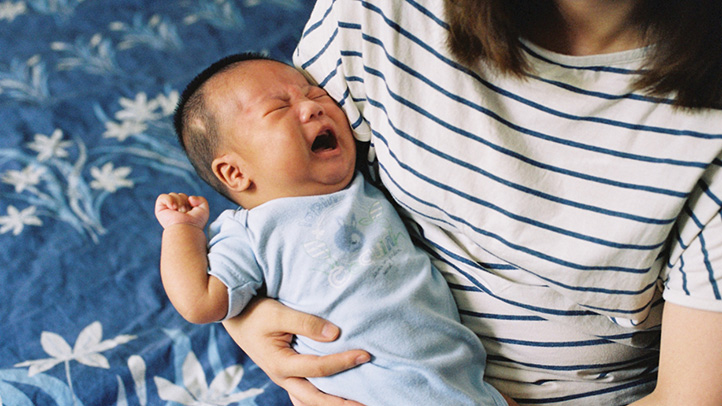Why Babies Cry When Put Down and How to Help?

Most parents agree that baby snuggles are delightful, but there are moments when you need to put your baby down. During those times, it can be frustrating and exhausting to hear your baby cry in protest.
Perhaps your baby sleeps soundly while you rock them, but their eyes pop open and they start to whimper when you lay them in their crib. Or they might start wailing when you set them on their playmat for a few minutes to use the bathroom or make a sandwich.
There are many reasons why babies are most content when held and cry when put down, including separation anxiety, discomfort, or adjusting to a new environment. Here’s how to soothe your baby when you can’t hold them and help them adjust to being physically apart from you.
Why Does My Newborn Cry When Put Down?
Newborn babies often cry when put down for a few different reasons.
They Want to Be Close to You
Newborns require a lot of attention from their caregivers, including physical closeness. They are used to the comfort of your cozy womb and the soothing sound of your heartbeat, so it’s natural for them to feel secure in your arms. Close contact also fulfills a biological need for newborns to form secure attachments, which is important for developing social and emotional skills.
They Startle Easily
Newborns experience a startle reflex (also known as the Moro reflex) that causes them to fling out their arms and legs and throw their heads back. This reflex often jolts sleeping babies awake and may frighten them, causing them to cry. The startle reflex should go away by about 2 months old.
They’re Going Through a Fussy Period
All babies cry, though your baby’s individual temperament and age may determine how much they cry and for how long. It’s common for new babies to seem to cry all the time, often for no discernible reason.
Some babies have colic, excessive crying that often peaks around 6 weeks old. Others may experience a lot of fussiness and crying from about 2 weeks to 3 or 4 months, known as the period of “purple crying.” This acronym stands for “Peak of crying,” “Unexpected,” “Resists soothing,” “Pain-like face,” “Long-lasting,” and “Evening.”
During these weeks, it can be really difficult to soothe your baby, and they may cry for several hours a day no matter what you do. Some newborns are especially fussy in the evening, a phenomenon known as the “baby witching hour.”
The period of PURPLE crying is a challenging time for parents. If you start to feel overly stressed or frustrated by your baby’s crying, put them down in a safe location (like their crib) and take a moment to yourself.
Why Does My Older Baby Cry or Scream When Put Down?
Older babies may also dislike being put down for a few different reasons:
Separation Anxiety
It’s common for babies to start experiencing separation anxiety around 8 or 9 months old. At this point, they have established attachments with their caregivers and understand object permanence—the idea that things and people still exist even when out of sight.
Separation anxiety is a normal part of your child’s development and a sign you’ve established a secure attachment. You can help ease separation anxiety with short “practice” sessions apart. Put your baby down in a safe place and tell them you’ll be back soon, then leave their sight for a few seconds. Slowly, your baby will learn that they’re okay while you’re gone and that you always come back.
Inability to Self-Soothe
Many babies love to be held and rocked at night or fed to sleep. Some may easily transfer to their own sleeping space, but others will wake when you put them down and struggle to self-soothe. This is a skill that takes time to learn and may come more naturally to some babies than others. You can help teach self-soothing by establishing a consistent bedtime routine and putting your baby down drowsy but awake.
How Do I Get My Baby to Stop Crying When I Put Them Down?
There are a few ways you can help your little one feel more comfortable so they won’t cry when you need to put them down:
Swaddle Them
Many newborns are soothed by swaddling, which involves wrapping your baby snugly in a thin blanket. The close fit of a swaddle resembles the coziness of the womb and helps prevent the startle reflex from waking your baby.
Wear Your Baby
Wearing your baby in a carrier mimics their experience in the womb. Many babies love being held close in a carrier, and your movement may even soothe them to sleep. Plus, wearing your baby allows you some freedom to use your hands.
Try a Bouncer or Swing
If your baby cries when you put them down on a play mat, try a bouncer or swing instead. Many babies love the back-and-forth motion of these devices, and using them can give you a much-needed break.
Ask for Help
Cuddling a newborn is one of the best parts of parenting, but there are times when you need to put your baby down and take care of yourself. Reach out to friends and family and let them help care for your baby so you can take a nap or a shower.
Try Sleep Training for Older Babies
By about 6 months old, most babies are developmentally able to establish self-soothing skills and sleep independently. You can help teach these skills with a sleep training method that helps your baby learn to sleep on their own. There are different methods to choose from, and the right one for you will depend on your baby’s temperament and your personal preference.




